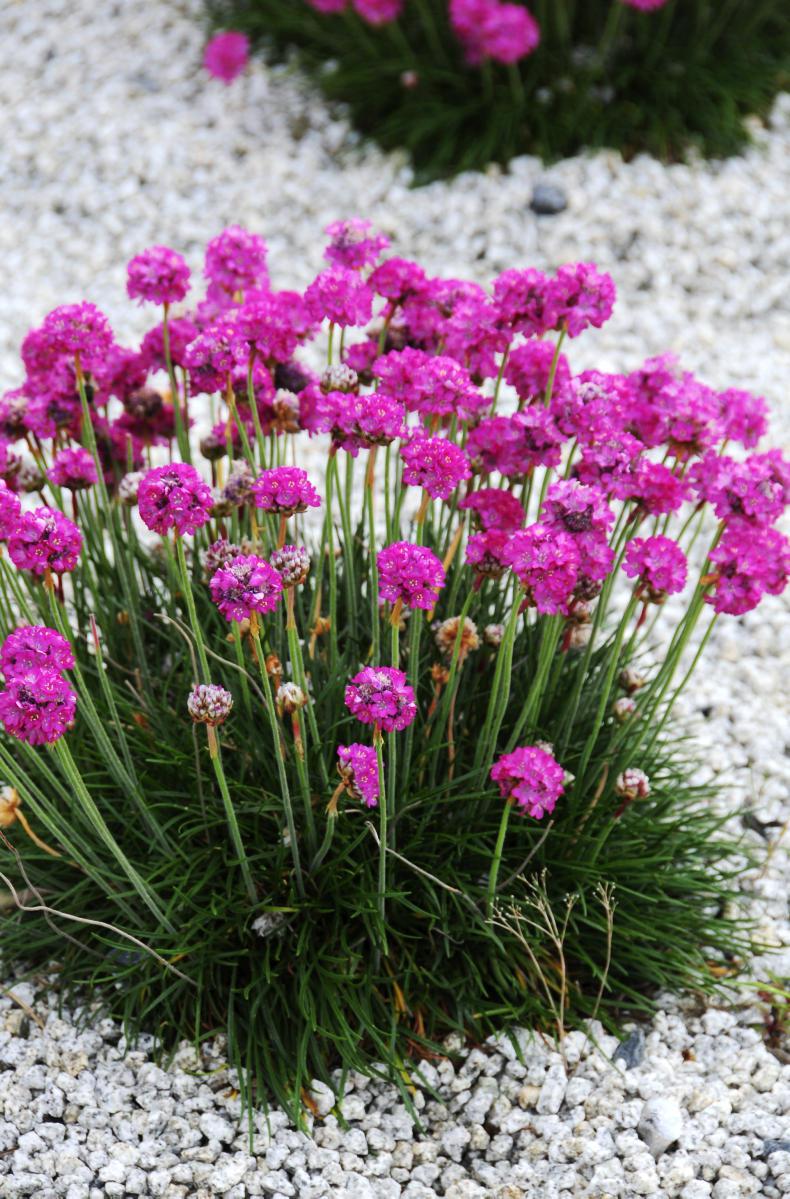Sea pink is a little gem of a plant with very pretty tufts of light pink or dark pink flowers on wiry stems held well about the narrow grassy leaves. When seen out of flower, it could easily pass for a tuft of short grass. But now, and through much of the summer, the plants produce their showy flowers.
It is also known by the common name of thrift, or armeria, which is its botanical name. It gets the name of sea pink because it grows on rocky shores around the coast – more plentiful in some places than in others.
For its small size, sea pink produces a remarkable show of flowers – but that is often the case with small plants, especially rock garden plants from mountain areas. To get themselves noticed – not by admiring humans but by essential pollinators – many alpine plants make outsize shows of flowers.
These flowers combined send out a strong signal to bees and other flying pollinators. The sea pink is a wild seaside plant here, found growing on dry, rocky shores, but it grows at greater altitude in other countries.
The thrift name reflects the very tough conditions in which it grows, usually in a patch of soil at the edge of a seaside bank or a crack in a rock filled with some soil, sand or seaside debris.
It hangs on tenaciously in these spots, resisting the direct damage of salt water spray, seaside gales and windblown sand. The narrow leaves are flexible and move in the wind to avoid damage and they are tough and waxy to reduce the danger of desiccation.
The flower stems are equally tough and wiry (up to 30cm tall), though usually less than half that height by the coast, the plants not growing as much when challenged by severe exposure.
Old plants often reveal how they survive so well, showing a tough, woody root where the soil is stripped away by wind and rain. The taproot root is small but strong and connects with the feeding roots that grow down deeply into the poor soil in the cracks of rock.
There are not many wild, native plants grown in Irish gardens, but the sea pink is one of them. The advantage of growing native plants in a garden is that they have long ago adapted to the climate and can cope with the weather. They are generally trouble-free, having few significant pests or diseases. For some reason, native plants also look more natural and more at home than exotics do, and with the increasing trend towards natural gardening, there is a place for this and other natives.
Sea pink can be a great addition to any garden and is particularly suitable for use in a rock garden, by the edge of paving, or the front of a sunny border with free-draining soil. There are various selected kinds in richer pink colours, such as ‘Vindictive’ which is deep rosy red. ‘Bee’s Ruby’ is light, bright purple pink. There are white forms too but they lack liveliness.
Armeria needs full sunshine and if it does not get it, it grows a lot of grassy leaves and produces just a smattering of flowers, even if the plant is shaded for part of the day, and it will eventually die out. The natural habitat of the plant gives a clear clue as to what it requires – not overly rich, well-drained soil in full sunshine, and open to every breeze that blows. CL
Plant some cosmos
It is still a bit risky to be planting out summer colour plants, but another week should see most of the country past the date of last frost. There is a trend toward more natural summer bedding effects. The lines and blocks of traditional bedding are being relegated to public parks. The airy habit and large long-lasting flowers of cosmos, on a tall plant, has seen its popularity rocket. It is not hardy but will not be caught out by frost now. Buy small plants or sow seeds in small pots or directly in the open soil for masses of pink, purple, red or white flowers until autumn.
Fruit, vegetables and herbs
Sow winter cabbage and cauliflower seeds for autumn and winter. Sow carrots, broccoli and peas to follow earlier sowing and repeat sowings of lettuce and scallions could be made. Thin out vegetable seedlings that have reached suitable size, and clear out weed seedlings at the same time.
Lawns
Despite chilly weather at times, grass has grown very well. Any lawn that is slow should get some lawn fertilizer or high-nitrogen fertilizer.
Carry out any lawn repairs or over-sowing, but not in a dry spell. Maintain regular mowing and trim the edges around flower beds or borders.
Trees, shrubs and roses
Prune spring shrubs, including forsythia, flowering currant, kerria and spring spirea as they go out of flower, if the bushes are getting too big or need shaping. Otherwise leave them alone. Check on young plants to make sure they are not suffering from drought after so much dry weather.
Flowers
Dahlia tubers and gladiolus corms can now be planted out where they are to flower. Slugs and snails can cause severe damage to hostas and ligularia.
Dahlias are often attacked as they come through the soil and sometimes this is difficult to spot. It is time enough yet for containers.
Greenhouse and house plants
Houseplants can be re-potted. Feed and water regularly. Plant out tomatoes, chilli peppers, cucumbers and sweet peppers as soon as space becomes available in the greenhouse. Plants are available in garden outlets. Feed greenhouse plants strongly now to get good growth.






SHARING OPTIONS